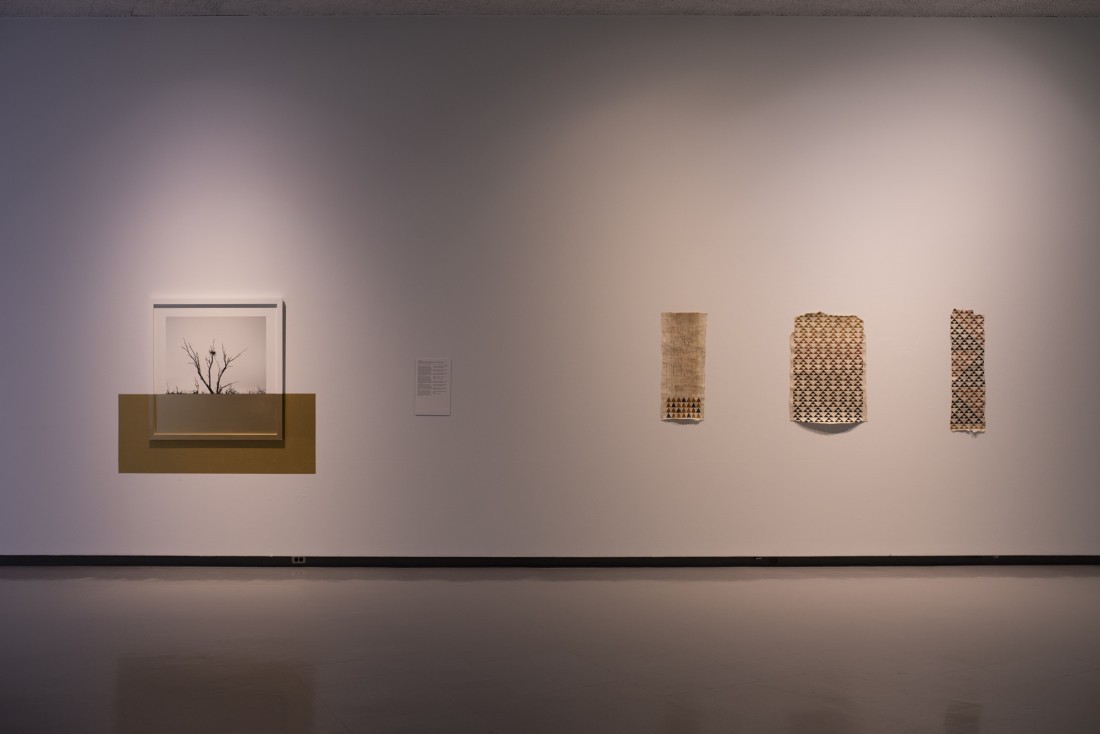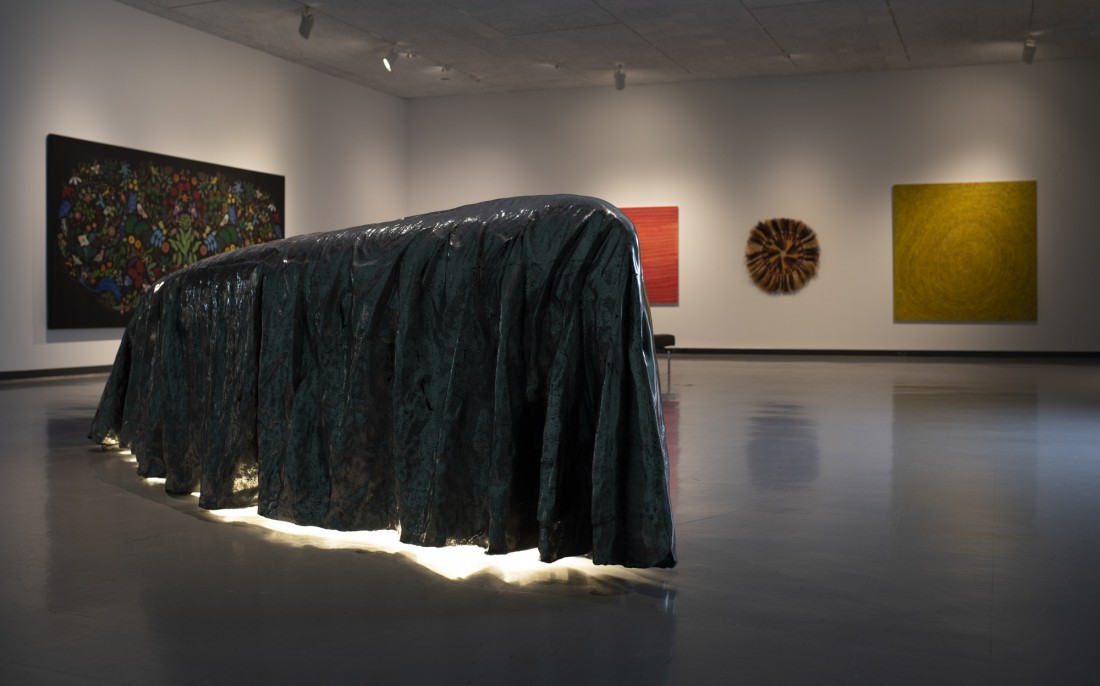“Nibi onje bimaadiziwin, Water is life”
One of two names for Manitoba is the Cree word “Manitowapow,” referring to the life that comes from the water. The other is “Manito Api,” a name that describes messages embedded in the land. This is why “Naadohbii: To Draw Water,” a remarkable 27 international artists’ exhibition examining Indigenous kinships with our most sacred medicine, is perfectly located— where both meet to inspire creativity, struggle and life.
Installed from August 2021 to February 2022 in the Winnipeg Art Gallery alongside Qaumajuq, the galler y’s new building addition, hosting the largest public collection of Inuit art in the world, “Naadohbii” provokes, evokes and innovates Indigenous concepts of water in its multiple webs of relatedness in Indigenous communities throughout Aotearoa, Australia and Turtle Island. Curated by an international curatorial cohort from all three spaces (Jaimie Isaac, Reuben Friend, Ioana Gordon-Smith and Kimberley Moulton), the exhibition embodies what curator and writer Natasha Ginwala calls an “axis of solidarity” by juxtaposing Indigenous intellectual traditions and expressions in a single space. The word “fluid” is all too often used as a trope and catch-all to describe the postmodern malaise, but in this exhibit the physical, mental and social fluidity of Indigenous pedagogy is a living, breathing entity embodied through every single expression, from the art to story to song.

Regina Pilawuk Wilson, Ngan’gikurrungurr/ Peppimenarti, Northern Territory Daly River region, Northern Territory, Australia, Walipan 1, 2, 3, and 4 (Fish Net), 2020, Pandanis, natural dye, dimensions variable. Photo: Serge Gumenyuk. Courtesy WAG-Qaumajuq.

Christi Belcourt, Michif, Mânitow Sâkahikan, Lake Huron, ON, Turtle Island (Canada), Water Song, 2010–2011, acrylic on canvas. National Gallery of Canada, Ottawa. Photo: Serge Gumenyuk. Courtesy WAG-Qaumajuq.
I began this review by trying to encapsulate each artist’s remarkable contribution, like Rebecca Belmore’s Body of Water and Christi Belcourt’s Water Song, remarking how each piece deftly examines the living property of what Aimée Craft in her essay “Life from Water” calls the “recognition of water as a sentient being with agency, the capacity to make decisions.” Then, I realized that each artist was trying to offer, to a collective vessel, the gifts their community and nation had obtained from the living properties of water and that the exhibit was like a canoe, paddling through. Kevin Brownlee’s Birchbark Canoe, which soared into the air in the middle of the exhibit, is both metaphor and material object for the viewer, who sees the art through a travelling but also immersive lens.
Of all the offerings, the Indigenous artists from Australia make some of the most provocative statements on the physical properties of water and how Indigenous communities use vessels to store and archive knowledge and life in water. Regina Pilawuk Wilson’s Syaw (Fish Net) and Wupun (Sun Mat) are encapsulations of the way water holds stories of continuance and being while Walipan 1, 2, 3, and 4 (Fish Net) are manifestations of these ideas, illustrating how functionality and representations of rock and earth in the weaving of fish traps become the fullest expression of a people living in relationship with struggle. At the same time, water is about navigation and recording journeys, as expressed by Nikau Hindin’s Te Awa Tupuna and Ngaru Nui, Ngaru Roa, Ngaru Paewhenua. It records migrations of a people as they mark their passage into spaces where beauty and dynamism are found. At the same time, water is real—a necessity for all life—so the pain felt in its lack (documented by James Tylor’s “Economics of Water” series of photographs) and its danger (as in Ishmael Marika’s RULYAPA) is a reminder of how water can both heal but also introduce life into other plains of being.
This is not to ignore the remarkable contributions of the Aotearoa artists, who introduce to the space centuries of oceanic experience and the aesthetics of movement. Water is inherently political, shown in Rachel Rakena and Keri Whaitiri’s Ahakoa he iti—referencing the controversial 2004 Foreshore and Seabed Act—and it is also deeply tied in the ways Indigenous communities and the land come together to forge relationality, claims and title, as evidenced by Nova Paul’s Ko ahau tew ai, ko tew ai ko ahau. Jeremy Leatinu’u introduces water as a “character” who acts independent of the ways humans seek to control it, subverting both container and form to ask “global questions of shortages and pollution” while showing how these will and do “rely upon knowledge and understandings embedded in our existing, often quotidian, relationships to water.”

Installation view, “Nibi onje bimaadiziwin, Water is life,” 2022, WAG-Qaumajuq, Winnipeg. Photo: Serge Gumenyuk. Courtesy WAG-Qaumajuq. Left to Right: James Tylor, Nunga (Kaurna) South Australia, Māori (Te Arawa) and European (English, Scottish, Irish, Dutch and Norwegian)/Ngunnawal country, Canberra, Australian Capital Territory, Aotearoa (New Zealand)/ Australia, Economics of Water #1 (Flood), 2018, gold paint on photograph. Nikau Hindin, Ngai Tupoto, Te Rarawa, Ngāpuhi, Aotearoa (New Zealand), Te Wheiao III, 2021, Aute, pigment. Nikau Hindin, Ngai Tupoto, Te Rarawa, Ngapuhi, Aotearoa (New Zealand), Te Awa Tupuna, 2021, Aute, pigment. Nikau Hindin, Ngai Tupoto, Te Rarawa, Ngapuhi, Aotearoa (New Zealand), Ngaru Nui, Ngaru Roa, Ngaru Paewhenua, 2021, Aute, pigment.
This brings me home to the Indigenous artists from Turtle Island, and in particular Manitowapow and Manito Api. In these experiences are the stories I know the most, which is also why poets like Katherena Vermette in her remarkable river woman and artists like Jaimie Black in Maawanji-idiwag (they come together) describe the Red River, the life found here and a motion so familiar in this place—a vision that both births and surrounds the exhibit. In a world where the motion of water is threatened, Christi Belcourt and Isaac Murdoch’s Onaman Collective creative works illustrate how, here, water is the singular path to the future. This is not to forget the remarkable Inuit pieces in the “Imaq” exhibit, all of which show how forms of ice and snow foster relations that feed, teach and warm us at the same time.

Foreground: Rebecca Belmore, Anishinaabe, Lac Seul First Nation, ON, Turtle Island (Canada), Body of Water, 2019, sculpture, cast aluminum. Commissioned by the 16th Istanbul Biennial. Produced with support from the Canada Council for the Arts. Collection of the artist. Photo: Serge Gumenyuk. Courtesy WAGQaumajuq.
Amongst my people, the Anishinaabe, we say “Nibi onje bimaadiziwin.” Water is life. This is the story of “Naadohbii: To Draw Water,” an exhibit that not only draws lines amongst the ripples but leaves songs of waves throughout the experience. Witnessing the teachings from all different directions, I was escorted through a millennia of intellectual knowledge and rich, vibrant Indigenous creativity through our interactions with our most sacred gift from the Creator. I thank all for coming to my home and adding this life to this place. ❚
“Naadohbii: To Draw Water” was exhibited at the Winnipeg Art Gallery, Winnipeg, from August 14, 2021, to February 6, 2022.
Niigaan Sinclair is Anishinaabe and professor and acting head of the Department of Indigenous Studies at the University of Manitoba, where he holds the professorship in Indigenous Knowledge and Aesthetics. He is also an award-winning writer and editor who was recently named to the Maclean’s “Power List” as one of the 50 most influential people in Canada.

